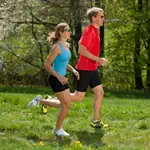
The human body is remarkable in its ability to make physiological and even psychological modifications to improve its exercise potential. Thus, it is possible for anyone to learn or re-learn how to become a faster and more efficient runner through good running form.
The body can adapt to the physical intensity and stress of training by facilitating greater degrees of efficiency and ability. Yet it won't just let go of old habits without the mind first being receptive to change and motivated to succeed. This is where mental determination combined with technical drill training comes in to ensure that those changes occur.
More: Do You Have Bad Running Form?
What follows are the basic upper-body characteristics that are important for efficient running.
Less skilled runners can learn to improve technique by understanding and implementing these elements when running. More skilled runners, on the other hand, may not know why they run well. For them, this information will be useful in fine-tuning and maintaining economical running form.
It is VERY important to understand that altering technique first begins with the assessment of your functional motion. That is, not how your body moves when running, but how you move in general. This can be examined with specific test that determine how functional your movements are. That's where flexibility, mobility and stability come into play.
More: Flexibility Training: Running Stretches
Keep this in mind when reading this or any article on technique. You MUST know how "functional" you are before changing most techniques. A good coach or physical therapist can help you with this.
Body Alignment
Good body alignment requires keeping the center of body mass (CBM) over the leg making contact with the ground (foot-strike). Having strong gluteals (hip stabilizers) is very important as each foot—at impact—balances the body. Instability or muscle weakness can result in wasted energy and contribute to injury.
More: 5 Exercises to Improve Running Mechanics
The ideal alignment can be achieved by keeping the front of the hips and torso slightly forward so that your foot lands more directly under your body, allowing your hips to extend freely (without restriction) as the leg pushes backward, propelling you forward.
More: 4 New Rules to Run Smart
- 1
- of
- 4
About the Author

www.evanscoaching.com | marc@evansoaching.com | YouTube | Facebook








Discuss This Article